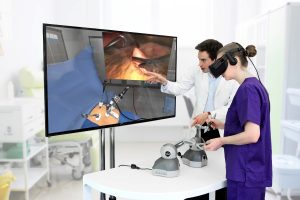 Virtual reality, the simulation of an environment that a user can interact with, and augmented reality, the superimposition of computer-generated images and sounds onto the real world, have gained the widespread use in video games and 3-D movies. But surprisingly, these technologies have found a growing number of diverse applications in medicine as well.
Virtual reality, the simulation of an environment that a user can interact with, and augmented reality, the superimposition of computer-generated images and sounds onto the real world, have gained the widespread use in video games and 3-D movies. But surprisingly, these technologies have found a growing number of diverse applications in medicine as well.
X-rays, CT scans, and MRI scans can be turned into high resolution 3-D images within minutes. Virtual reality games have proven valuable for treating post-traumatic stress disorder, and for making potentially painful or frightening medical procedures less distressing for children. Virtual reality headsets have also been successfully used to control pain during minimally invasive surgical procedures and to reduce anxiety in cancer patients requiring infusions.
But perhaps the fastest growing applications of these technologies are in the realm of surgery planning and training. Extremely complicated surgeries that require intensive, careful planning — like the separation of conjoined twins — can be modeled virtually before they are undertaken. Even more commonly, however, virtual reality is becoming a key component of the education of new surgeons, as it can provide effective, repeatable training at much lower cost than that using a medical cadaver.
 One developer of virtual reality training software has now added a realistic sense of touch to its surgical training platform. FundamentalVR has teamed with HaptX to integrate an advanced haptic glove with its virtual reality platform. The glove uses a microfluidic system that presses against a user’s skin to provide physical feedback, allowing users to feel the shape, texture, weight and movement of simulated objects, including rigid structures like bones. The glove can be paired with a haptic arm designed to simulate the use of a tool, like a scalpel, allowing the user to interact realistically with the virtual tissues, muscles, and bones of a simulated patient.
One developer of virtual reality training software has now added a realistic sense of touch to its surgical training platform. FundamentalVR has teamed with HaptX to integrate an advanced haptic glove with its virtual reality platform. The glove uses a microfluidic system that presses against a user’s skin to provide physical feedback, allowing users to feel the shape, texture, weight and movement of simulated objects, including rigid structures like bones. The glove can be paired with a haptic arm designed to simulate the use of a tool, like a scalpel, allowing the user to interact realistically with the virtual tissues, muscles, and bones of a simulated patient.
Initial training applications have been focused on orthopedic procedures such as posterior and anterior total hip replacements and total knee replacements. First launched in August 2018, the FundamentalVR surgery platform has already been used by Mayo Clinic, UCLA, University College Hospital of London, and the German hospital group, Sana.